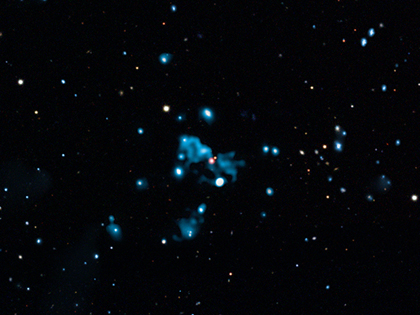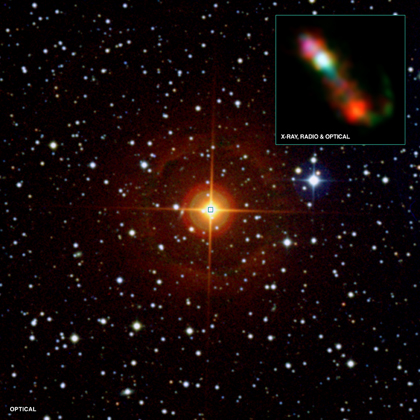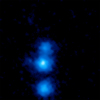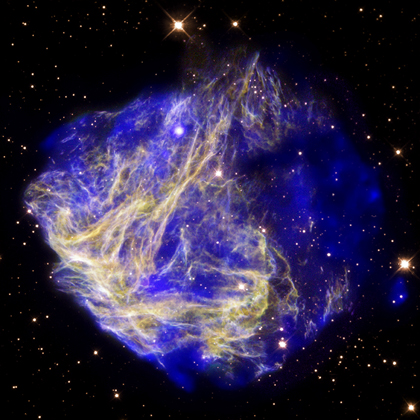A Black Hole Slingshot?
Evidence for a recoiling black hole has been found using data from the Chandra X-ray Observatory, XMM-Newton, the Hubble Space Telescope (HST), and several ground-based telescopes. A new paper reports that this black hole kickback was caused either by a slingshot effect produced in a triple black hole system, or from the effects of gravitational waves produced after two supermassive black holes merged a few million years earlier.
World Class Competition
While most of the world was focused on that little soccer tournament in South Africa, astrophysicists were involved with their own form of competition last week. As they do every year, experts from around the globe gathered to conduct the Chandra Peer Review process. This is the way that astronomers figure out what targets Chandra will observe over the course of the next year. Most major telescopes – such as Hubble and Spitzer -- have a similar process. And as they say about democracy, it's not a perfect system but it’s better than just about any other.

History Lesson
Jonathan Taylor, a Senior Lecturer in Creative Writing at De Montfort University in the UK, wrote a poem about the cosmic 'ghost' lurking around a distant supermassive black hole. His poem also appears in the literary magazine Acumen, issue 67, https://www.acumen-poetry.co.uk/. Jonathan is not only a poet, but a memoirist and novelist.

NASA’s Chandra X-ray Observatory has found a cosmic ‘ghost’ lurking around a distant supermassive black hole ....
(Chandra X-Ray Observatory, 28 May 2009)
Telescoped, the universe is a vast memory,
an over-long school-lesson in cosmic history,
background radiation droning on and on
from 300,000 years after the big bang,
remembering anything big enough (not us);
Elemental Change
Recently, I attended a memorial service for Geoffrey Burbidge, who was my thesis advisor many years ago. He was eulogized for his pioneering work in several fields of astrophysics. In the 1950's, he was the first to determine the enormous energies involved in the giant radio sources, calculations still used today in studying the process of black hole feedback in galaxy clusters. He and his wife Margaret were leaders in documenting violent events occurring in what they called active galactic nuclei, or AGN, as they are commonly called today. They also paved the way for work that eventually led to the conclusion that the universe is dominated by dark matter, a peculiar substance whose nature is still not understood.
A Close-up View of Codependent Stellar Living
This image shows the symbiotic system known as CH Cyg, located only about 800 light years from Earth. The large image shows an optical view of CH Cyg, using the Digitized Sky Survey, and the inset shows a composite image containing Chandra X-ray data in red, optical data from the Hubble Space Telescope (HST) in green, and radio data from the Very Large Array (VLA) in blue.
Science Takes Over Manhattan
Yesterday, the 2010 World Science Festival came to a climatic end with its Street Fair. This is the third year for this ambitious science festival that seems to take over Manhattan for several days. This year’s Street Fair spilled out from Washington Square Park into the streets around it.

Like last year, the Street Fair showcased Chandra images as part of the “From Earth to the Universe” project. The FETTU panels were arranged around the fountain in the middle of the park, providing a nice route for people to circle. The mood of the festival’s attendees was excited and upbeat – which is saying something on a very hot and humid day in New York City.
Heaven and Earth
There are a lot of reasons why people like astronomy. For some, it's the topics it covers like black holes, exploded stars, and distant planets. For others, it's the sense of awe that the cosmos inspires. There are also lots of people that just think the images are beautiful and worth gazing at. And, for most, it’s some combination of these and others that make them want to learn more about astronomy.
Stellar Shrapnel Seen in Aftermath of Explosion
This beautiful composite image shows N49, the aftermath of a supernova explosion in the Large Magellanic Cloud. A new long observation from NASA's Chandra X-ray Observatory, shown in blue, reveals evidence for a bullet-shaped object being blown out of a debris field left over from an exploded star.







